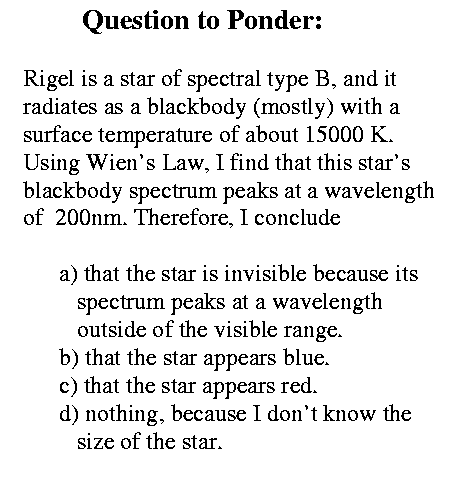|
|
Sun, Sun, Sun Here it Comes The Beatles, Here Comes the Sun |
Assignments:Problem Set #3 due Thursday 5pmCheck out the Special Web Page on the Observer's Triangle Read Chapter 24, section 3 (pp. 385-389) for Wednesday's class. NOTE: You are responsible for understanding the magnitude scale even though it will not be discussed in class.
|

In Class:
-------------------------
The Sun is not only hot
(we know its surface is hot from the light we see)
but it's even hotter inside than it is outside
-- needs to be, or it couldn't support itself
against gravitational collapse
Figured out by Eddington in the 1920s and 30s
interior temperature has to be 10-20 million K
outrageously hot
leads to another really fundamental problem
- what heats the Sun?
if there's no heat source
- Sun is losing energy through radiation all the time
- it should be cooling off
one way to keep up the heat
- gravitational contraction
- as parts of the Sun cool
- gravity starts to win
- squishes the Sun a bit more
- squished material heats up again
- back to hot Sun
- repeat this ad infinitum
- Sun slowly contracts, but stays hot
- obviously, you can only do this for a little while
- once the Sun is squished to a point
no more energy available
Can calculate the time this process would take,
given the Sun's current luminosity and the amount of gravitational
energy available (basically how much mass)
- 30 million years
- long time
But the Earth (and therefore probably the Sun) has been around for a lot
longer
-- we now think 4.5 Byr
-- even in the 20's > 1 Byr
--> SO GRAVITATIONAL CONTRACTION CAN'T WORK
The problem of figuring out why the Sun shines was called
the solar luminosity problem
and it was THE big question in science for 50 years or so around the
turn of the century
Solution comes from nuclear bomb research
-- need high T's to make nuclei fuse
-- nuclei, not atoms <-- important distinction
-- they don't like each other
-- positive charges
-- need to get close together to fuse
-- need high speed collisions
--> speed/particle = energy/particle = T
-- what kind of T's?
-- about 10-20 million for H
-- hmm, where have we seen that number before?
The Sun is a giant H-bomb
-- deep in it's interior
-- fusing H continuously
-- making energy just like a bomb
As long as it can make energy from fusion
as fast as it loses energy from radiation,
the Sun is stable
-- temperature structure doesn't need to change
-- doesn't need to shrink or expand
So keeping the Sun stable depends on keeping the nuclear fires fueled
-- Sun's lifetime depends on H supply
-- Sun is 80% H
- that's a lot
- lifetime based on available fuel supply: 10 billion years
-- this lifetime is much more consistent with ages of rocks on Earth,
and other methods of dating objects in the SS
--------------------------------------
So the picture gets clearer:
Stars have to be big
- need high mass to create high temperatures
for fusion
-- e.g., Jupiter just won't do it
Stars have to be made out of mainly H
- fuel source
- H fusion is the easiest to do
--------------------------------------------------------
--------------------------------------
OK, so the Sun is a star, and it shines from gravity, which creates
the pressure and temperature that allows for nuclear fusion to take place
But what about all those twinkly lights in the sky?
are they Suns too?
as bright as the Sun?
as big as the Sun?
Why do you believe this?
-- cuz I told you?
-- you're very gullible
How can they possibly be as luminous as our Sun when they look like
little dots?
-- you can't tell how far away they are
just from how bright they are
-- fireflies
-- satellites
-- planets
-- faint object up close of bright object far away?
So how can you tell?
Measuring distance
-- yardstick
-- really comparative measuring
-- I am 1.96 times the height of a yardstick
tall
-- I-80 is 7 times the distance of a mile
away
-- This class is 53 times the duration of one
minute long
-- can reference to anything
-- yard is king's arm length
-- meter is 1/40000 Earth's circ
--> need to go out and measure distances physically
-- compare yardstick to me
-- use odometer to I-80
-- stopwatch for class
--> hard to do in space
-- radar
-- light pulse sent out
-- wait for return
-- time is measure of distance
-- speed of light known
-- distance light travels in
one sec == 1 l-s
-- distance in light-seconds
is number of seconds
it takes light to get
there
LIGHT-SECONDS, LIGHT-DAYS, LIGHT-MONTHS, and LIGHT YEARS
ARE MEASURES OF DISTANCE NOT TIME!!!!!!!!!
-- radar is ok for planets (time= hours)
-- star too far away (time=years)
Other methods: apparent diameter
-- distance from building can be calcuated if you know its
height
(say 200 ft)
-- how big does it appear? (angle)
(say 5 degrees)
as long as alpha is small, this is nearly a right triangle
consider the right triangle
tan(alpha) = height/distance
--> distance = height/tan(alpha)
= 200 ft/tan(5)
= 2286 ft (about a half-mile)
we say that the building has an angular size of 5 degrees when viewed from
a distance of 2286 ft
we can make it even easier, since for small angles tan(alpha) ~= alpha/57.3
(see Special Web Page)
so,
alpha/57.3 = height/distance (called the "Observer's Triangle")
|
![]()